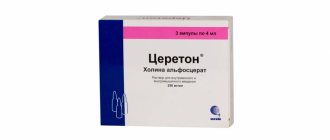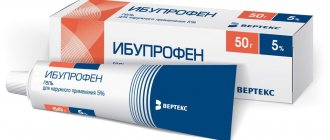Pharmacodynamics and pharmacokinetics
This is a combined drug that has a vasodilator, analgesic and analgesic effect. A good antispasmodic, which determines the use of Andipal for blood pressure.
Metamizole sodium, which is part of the composition, reduces body temperature and relieves pain. Once in the gastrointestinal tract, the substance is well and quickly absorbed and blocks the prostaglandin system of arachidonic acid, increasing the sensitivity threshold of pain centers in the hypothalamus .
Papaverine hydrochloride dilates blood vessels (reduces the level of calcium in cells) located on the periphery and significantly reduces the overall tone of the smooth muscles of the surface of internal organs.
Bendazole is an antispasmodic, dilates blood vessels, stimulates the spinal cord, and restores nerve endings in the periphery.
Phenobarbital exhibits its sedative properties and enhances the effects of other components of the drug.
Mechanism of action of the drug
Andipal has established itself as an effective antispasmodic, quickly normalizing blood pressure and relieving symptoms associated with hypertension: severe headache, feeling of heat, tachycardia, nervous agitation.
- Analgin slows down the release of prostaglandins of the arachidonic group, reduces pain, and affects the activity of the body's thermoregulation center.
- Papaverine slows down the flow of calcium into cells, reduces vascular tone, relaxes smooth muscle fibers, eliminating peripheral spasms. Helps improve blood supply to internal organs and reduce headaches.
- Bendazole complements the action of papaverine, dilates the vascular bed, improves the functions of the spinal cord, eliminates the feeling of body numbness, dizziness and other neurological symptoms.
- Phenobarbital reduces nervous excitement, reduces sensitivity to stress factors, calms, and helps eliminate insomnia.
The active substances used together reduce the symptoms of disorders of the heart, blood vessels, central nervous system, and internal organs.
The tablets quickly dissolve under the action of gastric juice and are absorbed into the blood. The effect of the drug develops within 15–30 minutes and lasts up to 8–10 hours. The substances do not accumulate in the body; they are transformed in the liver. Metabolites are excreted with intestinal contents and through the kidneys.
Indications for use of Andipal. What does it help with?
Andipal tablets, what are they for?
- Indications for the use of the drug are migraines of various types.
- Pain associated with spasms of cerebral vessels in the head.
- The medicine helps against pain caused by spasms of smooth muscles or internal organs of the gastrointestinal tract.
- For mild forms of hypertension, it can be used as blood pressure pills.
What blood pressure should I take the medicine for? For primary or secondary hypertension, Andipal can be taken for high blood pressure.
Who should use Andipal?
The drug is prescribed for pain caused or accompanied by vascular spasms, increased blood pressure:
- for migraines: mild to moderate;
- tension headaches;
- symptoms of weather dependence;
- pain and spasms in the area of the gallbladder, liver, pancreas, intestines associated with impaired vascular tone or spasms of the muscles of internal organs;
- for pain in the pelvic organs;
- for high blood pressure: in complex therapy of primary and secondary hypertension at the initial stage.
During the period of use of the medicine, the total amount of NSAIDs and antispasmodics used together with Andipal should be taken into account in order to avoid an overdose.
Contraindications
- Acute increased sensitivity to the constituent substances of the drug (especially pyrazolone).
- For glucose-6-phosphate dehydrogenase deficiency, various blood diseases, porphyria.
- Severe dysfunction of the kidneys and liver, tachyarrhythmia , angina pectoris, intestinal obstruction .
The use of the drug is contraindicated for children under 8 years of age during lactation.
Contraindications to the use of Andipal
It is necessary to stop using the drug if you are prone to hypotension, habitual low blood pressure, individual intolerance to metamizole or other components, blood disorders, severe chronic liver diseases, cirrhosis, intestinal obstruction.
Andipal is prohibited for use during pregnancy and breastfeeding. It should not be given to children under 14 years of age.
Neglect of contraindications or overdose of the drug causes increased side effects and intoxication. Possible signs of poisoning:
- severe headache;
- impaired coordination of movements;
- nausea, vomiting, pain in the epigastric region;
- vascular collapse;
- angioedema;
- skin itching, urticaria.
Negative reactions are possible within a few minutes after taking the medicine or within several days while therapy is continued.
Side effects
According to the annotation: constipation , nausea , various allergic reactions ( conjunctivitis , urticaria, Quincke's edema ), nephritis , red urine , drowsiness , increased sweating .
With long-term use, agranulocytosis , leukopenia , and thrombocytopenia .
Before use, you should consult your doctor.
Andipal
The frequency of these side effects is indicated in accordance with the WHO classification: very often - more than 10%; often - more than 1% and less than 10%; infrequently - more than 0.1% and less than 1%; rarely - more than 0.01% and less than 0.1%; very rarely - less than 0.01%, including isolated cases: frequency unknown - based on available data, it was not possible to establish the frequency of occurrence.
For Andipal:
To date, no side effects have been reported with this combination. The incidence of the following possible side effects is unknown.
From the central nervous system
: drowsiness, decreased speed of psychomotor reactions.
From the digestive system
: nausea, constipation.
From the cardiovascular system
: arterial hypotension.
Allergic reactions
:
With long-term use
: leukopenia, agranulocytosis, impaired liver and kidney function.
For Metamizole sodium:
From the skin
: uncommon - persistent drug rash; rarely - rash (for example, maculopapular); very rarely - Stevens-Johnson syndrome, toxic epidermal necrolysis.
From the urinary system
: very rarely - acute renal dysfunction, which in very rare cases can lead to proteinuria, oligo- or anuria and acute renal failure, acute interstitial nephritis.
From the hematopoietic organs
: rarely - leukopenia; very rarely - agranulocytosis, including fatal cases, thrombocytopenia; frequency unknown - aplastic anemia, pancytopenia, including fatal cases.*
*These reactions can occur even if metamizole sodium has not previously caused complications. There are a number of signs of an increased risk of agranulocytosis if metamizole sodium is used for more than one week. This reaction is dose-independent and can occur at any time during treatment. It is manifested by high fever, chills, sore throat, pain when swallowing, inflammation of the mucous membranes of the mouth, nose, throat, genital and anal area. However, when antibiotics are used, these phenomena may be mild. There is a slight enlargement of the lymph nodes and spleen or no enlargement at all. The erythrocyte sedimentation rate increases significantly, the content of granulocytes is sharply reduced or they are not detected. As a rule, but not always, normal levels of hemoglobin, red blood cells and platelets are maintained. Treatment tactics involve immediate discontinuation of the drug, i.e. the drug should be discontinued immediately, without waiting for laboratory results, if there is an unexpected deterioration in the general condition, the fever does not subside, or new or painful ulcerations appear on the mucous membranes, especially in the mouth, nose or throat. If pancytopenia occurs, the drug should be discontinued immediately and a complete blood count should be monitored until its values return to normal.
From the cardiovascular system
: uncommon - isolated decrease in blood pressure (possibly pharmacologically caused and not accompanied by other manifestations of anaphylactic/anaphylactoid reactions). The decrease in blood pressure can be pronounced. During fever, a dose-dependent sharp decrease in blood pressure without other signs of a hypersensitivity reaction is also possible.
Allergic reactions
: rarely - anaphylactoid or anaphylactic reactions; ** very rarely - analgesic bronchial asthma. In patients with analgesic bronchial asthma, intolerance usually manifests itself as attacks of bronchial asthma; frequency unknown - anaphylactic shock. **
**These reactions are especially common with parenteral administration of metamizole sodium and can be severe and life-threatening, in some cases leading to death. These reactions can occur even if metamizole sodium has not previously caused complications. These reactions may occur during administration or immediately after ingestion, or develop several hours later. However, they predominantly occur within the first hour after application. In milder cases, they manifest as rashes on the skin and mucous membranes (eg, itching, burning, redness, blistering and swelling), shortness of breath and, less commonly, gastrointestinal disorders. In severe cases, these mild reactions can develop into generalized urticaria, severe angioedema (including of the larynx), severe bronchospasm, cardiac arrhythmia, arterial hypotension (in some cases preceded by an increase in blood pressure), shock. In this regard, at the first signs of skin reactions, the drug should be discontinued.
Others
: Not known - Red urine has been reported and may be due to the presence of low concentrations of rubazonic acid (a metabolite of metamizole sodium).
For Phenobarbital:
From the central nervous system
: frequency unknown - asthenia, dizziness, general weakness, ataxia, nystagmus, paradoxical reaction (especially in elderly and weakened patients - agitation), hallucinations, depression, nightmares, syncope.
From the digestive system
: frequency unknown - vomiting, liver dysfunction with long-term use.
From the hematopoietic organs
: frequency unknown - agranulocytosis, megaloblastic anemia, thrombocytopenia.
Allergic reactions
: frequency unknown - skin rash, urticaria, swelling of the eyelids, face and lips, difficulty breathing, rarely - exfoliative dermatitis, malignant exudative erythema (Stevens-Johnson syndrome).
Others
: frequency unknown - with long-term use drug dependence.
For Bendazole:
The listed effects appear when used in large doses. When the dose is reduced or the drug is discontinued, these side effects quickly disappear.
From the central nervous system
: frequency unknown - dizziness, headache.
From the skin:
frequency unknown - increased sweating.
From the digestive system
: frequency unknown - nausea.
For Papaverine hydrochloride:
From the central nervous system
: often - drowsiness.
From the skin
: often - skin rash (usually erythematous, urticaria), infrequently - itching, rarely - increased sweating.
From the digestive system
: often - nausea, constipation, infrequently - increased activity of liver transaminases.
From the cardiovascular system:
often - decreased blood pressure, infrequently - ventricular extrasystole.
From the hematopoietic organs
: very rarely - eosinophilia.
Instructions for use of Andipal (Method and dosage)
How to use the drug? Inside. Adults should take 1-2 tablets 2-3 times a day. The full course of treatment should take 7-10 days.
Before taking the medicine, consult your doctor. The course of treatment should be prescribed by a specialist, depending on the nature of the disease and its course. It is not recommended to take the drug for more than 10 days.
How to take if you have high blood pressure? Does Andipal increase or decrease blood pressure?
The drug has a hypotensive effect and is used for high blood pressure. Cannot be used for hypotension, this can lead to harmful changes in the brain.
Interaction
The use of astringents, enveloping agents and activated carbon reduces absorption in the gastrointestinal tract.
When combined with other antispasmodics and sedatives, the hypotensive effect of the drug is enhanced. diabetes medications increases . Enhances the effect of glucocorticosteroids , Indomethacin and ethanol . Reduces the concentration of cyclosporine in the blood.
Inducers of microsomal liver enzymes ( barbiturate , phenylbutazone ), analeptics ( camphor , Cordiamin ), tonics ( Eleutherococcus , ginseng root) reduce the effectiveness of the drug.
Dosage form and composition of Andipal
The medicine is intended for oral administration and is available in the form of flat-cylindrical tablets of yellowish or white color, bitter taste, without a coating and a distinct odor. Each pill contains:
- analgin (metamizole): 250 mg;
- bendazole: 20 mg;
- papaverine hydrochloride: 20 mg;
- phenobarbital: 20 mg.
Auxiliary formative compounds of the drug: starch, talc, stearic acid. Tablets are packaged in foil or paper blisters. One package of medication contains from 10 to 100 pieces.
The combination of an analgesic, antispasmodics and sedative in the drug provides a simultaneous analgesic, antipyretic effect, reduces vascular tone, preventing the development of heart attacks and hypertensive crisis.
special instructions
With long-term use of Andipal, the overall picture of peripheral blood should be monitored.
It is recommended to be careful and vigilant when working with mechanisms, due to the fact that the drug significantly affects the change in the reaction rate.
Does the medicine lower or increase blood pressure?
The medicine lowers blood pressure.
At what pressure should Andipal be taken?
With high blood pressure.
Andipal should be used as a medicine for blood pressure after consulting a doctor.
Analogues and substitutes
Level 4 ATC code matches:
Analdim
Reopirin
Tempalgin
Spazgan
Benalgin
Pentalgin ICN
Pentalgin N
Pentalgin
Analgin
Renalgan
Tetralgin
Spasmalin
Maxigan
Sedal-M
Piralgin
Baralgin M
Sedalgin Plus
Baralgetas
Revalgin
The drug has no analogues in terms of its main active ingredient.
Analogs for antispasmodic effect:
- Nomigren
- Papazol-UBF
- Papazole
- Urolesan
- No-Shpalgin
- Unispaz
- Teodibaverin
Price for Andipal
Andipal tablets in Russia will cost about 40 rubles per pack of 20 pieces.
In Kyiv pharmacies the price of tablets will be about 20 UAH. for 10 pcs.
- Online pharmacies in RussiaRussia
- Online pharmacies in UkraineUkraine
- Online pharmacies in KazakhstanKazakhstan
ZdravCity
- Andipal Avexima tablets 10 pcs. Avexima Siberia LLC
63 RUR order - Andipal avexima tab. n20 LLC Avexima Siberia
86 rub. order
- Andipal tablets 20 pcs. PharmstandardPharmstandard-Leksredstva OJSC
45 rub. order
- Andipal tablets 10 pcs. PharmstandardPharmstandard-Leksredstva OJSC
18 rub. order
- Andipal tablets 20pcs JSC "PFK Obnovlenye"
89 rub. order
Pharmacy Dialogue
- Andipal (tab. No. 20) FS.-Leksredstva
37 RUR order
- Andipal (tab. No. 10) FS.-Leksredstva
15 rub. order
- Andipal (tab. No. 20)Updating PFC CJSC
90 rub. order
- Andipal Avexima tablets No. 20 Anzhero-Sudzhensky chemical-f.z.
83 RUR order
show more
Pharmacy24
- Andipal forte No. 100 tablets PAT Monfarm, Ukraine
154 UAH.order - Andipal V No. 10 tablets PAT Monpharm, Ukraine
16 UAH order
- Andipal forte No. 10 tablets PAT Monpharm, Ukraine
17 UAH order
- Andipal-V No. 100 tablets PAT Monpharm, Ukraine
152 UAH order
PaniPharmacy
- Andipal tablets Andipal B tablet. No. 10 Ukraine, Monfarm JSC
21 UAH order
- Andipal-Forte tablets Andipal-Forte tablets. No. 100 Ukraine, Monfarm JSC
171 UAH order
- Andipal tablets Andipal-B tablet. No. 100 Ukraine, Monfarm JSC
194 UAH order
- Andipal-Forte tablets Andipal-Forte tablets. No. 10 Ukraine, Monfarm JSC
22 UAH order
show more








